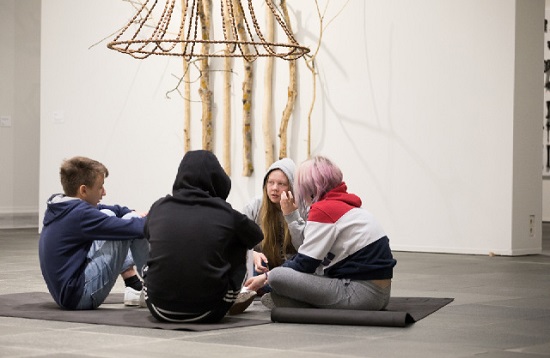
Pupils participate in an exhibition Oulu Arts Museum as part of the Art Testers campaign
Photo: Anni Martikainen
Giving all children access to the arts: Finland’s plan for cultural education
Every teenager in Finland will get free visits local and national arts institutions, thanks to the country’s “innovative” plan for cultural education. Aleksi Valta describes how communities are building cultural competency from the ground up.
This month, my son’s second grade class experienced a dance theatre performance, followed by a dance workshop at their school by a local dance artist. In October they will go and see the Tampere Philharmonic Orchestra in a concert. My daughter’s sixth grade class saw the Tampere Philharmonic in concert in a performance of Romeo and Juliet that included some ballet. Next they will visit a museum led by a museum pedagogist. My youngest child and her early childhood education group will also be visiting a museum more suitable for a younger audience, most likely the Moomin museum. These school day activities are part of the Art Arc (Taidekaari) initiative coordinated by the City of Tampere.
Art Arc is a comprehensive cultural programme designed for pupils. The aim of the programme is to create an unbroken span of learning throughout children’s school life to familiarise them with different fields of art. All schools in Tampere are included in the programme but few parents are aware their children are privileged to participate in this initiative, or that not all cities and municipalities in Finland offer such a programme – yet.
Building cultural competence
Finalnd’s innovative approach to cultural education ensures that all Tampere’s children and young people come into contact with their local cultural institutions, including theatres, music halls and museums. Cultural Education Plans are agreements at a municipal level between the educational and cultural sectors to detail the systematic implementation of culture, art and cultural heritage education in a municipality’s teaching programme. The plan, implemented by either a city, a municipality or a collective of municipalities working together, typically concerns pupils in grades 1 to 9 (ages 7 to 16) but ideally extends to early childhood education, high schools and vocational schools. Children become familiar with different art forms and local cultural heritage, and are given the opportunity to create their own art.
It has been a common practice to expose young people to art they ‘ought to’ appreciate … it is equally important to let the opinion of the youth be heard.
Children’s cultural centres have strongly influenced the development of these plans by organising seminars and providing information to teachers, principals and cultural professionals. Long-term cooperation between the National Association of Finnish Children’s Cultural Centres, Ministry of Education and Culture, the University of the Arts, and the Artsequal research initiative has helped embed art education firmly in the structures of the Finnish school system. By building on local character, schools’ strengths and collaborative participation, cultural competence is integrated into formal education.
The political value of Cultural Education Plans is significant because they spread the benefits of art and culture to all children and strengthen the cultural competence of whole age groups. Article 31 of the UN’s Declaration of the Rights of the Child states: “parties shall respect and promote the right of the child to participate fully in cultural and artistic life and shall encourage the provision of appropriate and equal opportunities for cultural, artistic, recreational and leisure activity.” Cultural Education Plans have proven to be an effective tool to guarantee children’s equal access and opportunity to engage with arts and culture. So far, approximately one-third of Finnish municipalities have launched a systematic cultural education plan. Further work needs to be done.
The Art Testers campaign
The Art Testers Campaign is the crowning jewel of Cultural Education Plans in Finland. From 2017 to 2020, every eighth grader will be offered two pre-arranged visits to performances or exhibitions. One visit will take place in their own region and the other in the Helsinki area. The aim of the Art Testers Campaign is to provide young people with an opportunity to experience art, including the kind of art many would not normally have access to. Everyone is guaranteed a place, regardless of disability or distance. The programme covers all parts of Finland from outskirts of Lapland to the most remote islands in the south and is offered in both of its official languages (Finnish and Swedish).
In addition to engaging hands-on activities in a variety of artistic disciplines, art institutions are also required to offer pupils preparatory activities such as workshops, backstage visits or interviews. It is important to address any questions the children have – these unforgettable experiences may trigger a lifelong interest in culture, but the campaign also strives to give young people the tools to process emotions that might arise during the performance. It has been a common practice to expose young people to art they ‘ought to’ appreciate. In the Art Testers, it is equally important to let the opinion of the youth be heard.
As the title suggests, the pupils are ‘testing’ art, with the test results being made available to larger audiences. With this in mind, a web-based service has been developed. The feedback data is visualized and added in real time to the Art Testers’ website (www.taidetestaajat.fi), where anyone can follow the flow of commentary and statistics as it develops. Art Testers could well be the largest organised “art critic” ever!
Aleksi Valta is the Executive Director of the Association of Finnish Children’s Cultural Centres
Join the Discussion
You must be logged in to post a comment.